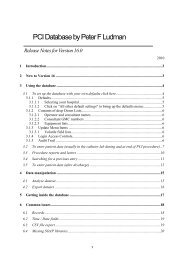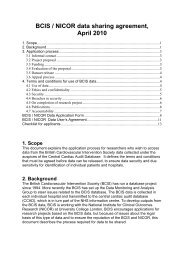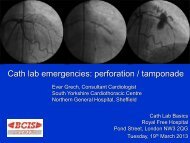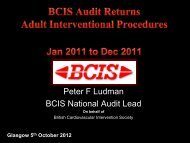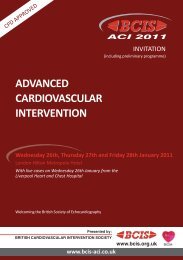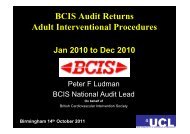Recommendations
ACC/AHA/SCAI PCI Guidelines - British Cardiovascular Intervention ...
ACC/AHA/SCAI PCI Guidelines - British Cardiovascular Intervention ...
- No tags were found...
You also want an ePaper? Increase the reach of your titles
YUMPU automatically turns print PDFs into web optimized ePapers that Google loves.
20<br />
Smith et al. 2005<br />
ACC/AHA/SCAI Practice Guidelines<br />
ACC - www.acc.org<br />
AHA - www.americanheart.org<br />
SCAI - www.scai.org<br />
3.5.4. The Elderly Patient<br />
Age greater than 75 years is one of the major clinical variables<br />
associated with increased risk of complications (211-<br />
214). In the elderly population, the morphologic and clinical<br />
variables are compounded by advanced years, with the very<br />
elderly having the highest risk of adverse outcomes (215). In<br />
octogenarians, although feasibility has been established for<br />
most interventional procedures, the risks associated with<br />
both percutaneous and nonpercutaneous revascularization<br />
are increased (216-218). Octogenarians undergoing PCI have<br />
a higher incidence of prior MI, lower LV ejection fraction,<br />
and more frequent HF (219,220). In the stent era, procedural<br />
success and restenosis rates are comparable to those for<br />
nonoctogenarians, albeit with higher incidences being<br />
reported for in-hospital and long-term mortality and for vascular<br />
and bleeding complications (221). A multicenter study<br />
compared an early invasive strategy versus an early conservative<br />
strategy in 2220 patients hospitalized for UA/NSTE-<br />
MI. Among patients 65 years or older, the early invasive<br />
strategy conferred a 4.8% absolute risk reduction (39%<br />
Relative Risk Reduction [RRR]) in death or MI at 6 months.<br />
In a post hoc analysis, patients aged 75 years or older experienced<br />
a 10.8% reduction (56% RRR) in 6-month death or<br />
MI with an early invasive strategy. However, there was a significant<br />
major bleeding rate in patients aged 75 years or older<br />
assigned to an invasive versus a conservative strategy<br />
(16.6% vs 6.5%, P equals 0.009) (222). For patients enrolled<br />
in the Controlled Abciximab and Device Investigation to<br />
Lower Late Angioplasty Complications (CADILLAC) trial<br />
of PCI for STEMI using routine stenting versus balloon<br />
angioplasty, with or without abciximab administration in<br />
both revascularization strategies, 1-year mortality increased<br />
exponentially for each decile of age after 65 years (1.6% for<br />
patients less than 55 years, 2.1% for 55 to 65 years, 7.1% for<br />
65 to 75 years, 11% for greater than 75 years; P less than<br />
0.0001). The incidence of stroke and major bleeding was also<br />
increased in the elderly at 1 year. Abciximab administration<br />
did not confer a benefit in elderly patients but was deemed<br />
safe. In contrast, routine stent implantation in elderly patients<br />
reduced 1-year rates of ischemic target-vessel revascularization<br />
(7.0% vs 17.6%, P less than 0.0001) and subacute or late<br />
thrombosis (0% vs 2.2%, P equals 0.005) compared with balloon<br />
angioplasty. The authors acknowledged that additional<br />
risks/benefits of stent or IIb/IIIa inhibitor use in elderly<br />
patients with STEMI might have become evident had more<br />
patients been enrolled in this study (223). Thus, with rare<br />
exception (primary PCI for cardiogenic shock in patients<br />
greater than 75 years of age), a separate category has not<br />
been created in these guidelines for the elderly (224).<br />
However, their higher incidence of comorbidities and risk for<br />
bleeding complications should be taken into account when<br />
considering the need for PCI (218,225).<br />
3.5.5. Diabetes Mellitus<br />
In the TIMI-IIB study of MI, patients with diabetes mellitus<br />
had significantly higher 6-week (11.6% vs 4.7%), 1-year<br />
(18.0% vs 6.7%), and 3-year (21.6% vs 9.6%) mortality rates<br />
than nondiabetic patients (226). Patients with diabetes with a<br />
first MI who were randomly assigned to the early invasive<br />
strategy faired worse than those managed conservatively<br />
(42-day mortality: death or MI, or death alone, 14.8% vs<br />
4.2%; P less than 0.001) (227). An early catheterization and<br />
intervention strategy after fibrinolysis was of little benefit in<br />
these patients with diabetes. Although adjusted in-hospital<br />
mortality was not different in diabetic and nondiabetic<br />
patients, data from the NHLBI registry showed that at 1 year,<br />
adjusted mortality and repeat revascularization were significantly<br />
higher in diabetics (228). Thus, routine catheterization<br />
and PCI in this patient subgroup should be based on clinical<br />
need and ischemic risk stratification.<br />
Stenting decreases the need for target-vessel revascularization<br />
procedures in diabetic patients compared with PTCA<br />
(229). The efficacy of stenting with GP IIb/IIIa inhibitors<br />
was assessed in the diabetic population compared with those<br />
without diabetes in a substudy of the EPISTENT (Evaluation<br />
of IIb/IIIa Platelet Inhibitor for Stenting) trial (230). One<br />
hundred seventy-three diabetic patients were randomized to<br />
stent/placebo combination, 162 patients to stent/abciximab<br />
combination, and 156 patients to PTCA/abciximab combination.<br />
For the composite end point of death, MI, or target-vessel<br />
revascularization, the rates were as follows: 25%, 23%,<br />
and 13% for the stent/placebo, PTCA/abciximab, and<br />
stent/abciximab groups (P equals 0.005). Irrespective of<br />
revascularization strategy, abciximab significantly reduced<br />
6-month death and MI rate in patients with diabetes for all<br />
strategies. Likewise, 6-month target-vessel revascularization<br />
was reduced in the stent/abciximab group approach. Oneyear<br />
mortality for diabetics was 4.1% for the stent/placebo<br />
group and 1.2% for the stent/abciximab group. Although this<br />
difference was not significant, the combination of stenting<br />
and abciximab among diabetics resulted in a significant<br />
reduction in 6-month rates of death and target-vessel revascularization<br />
compared with stent/placebo or PTCA/abciximab<br />
therapy (230). Similar results in 1-year target-vessel<br />
revascularization and mortality have been reported with<br />
abciximab and the small-molecule GP IIb/IIIa inhibitor<br />
tirofiban (231). (See Section 6.2.2 Glycoprotein IIb/IIIa<br />
Inhibitors.) The BARI trial, in which stents and abciximab<br />
were not used, showed that survival was better for patients<br />
with treated diabetes undergoing CABG with an arterial conduit<br />
than for those undergoing PTCA (232). The benefit of<br />
CABG in patients with diabetes may be related to lessened<br />
mortality after subsequent Q-wave MI among patients with<br />
diabetes. In the BARI trial, the benefit of bypass surgery in<br />
diabetic patients was greater in those patients with more<br />
extensive disease (e.g., more than 4 lesions). This advantage<br />
was largely due to a lower mortality for subsequent MI<br />
(233).<br />
Since the BARI trial was completed, several studies have<br />
assessed the use of PCI with stenting versus CABG in<br />
patients with multivessel disease. Patients with diabetes were<br />
assessed specifically in studies from the ARTS (Arterial<br />
Revascularization Therapies Study) and AWESOME (Angina



